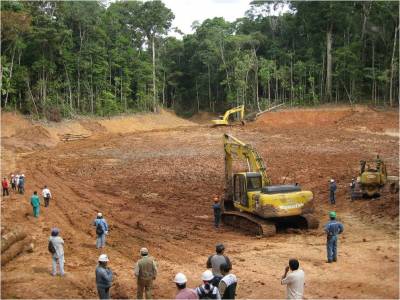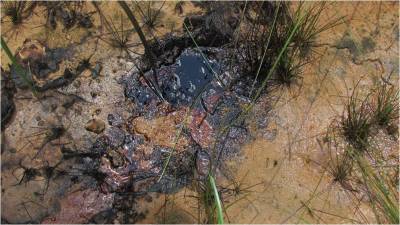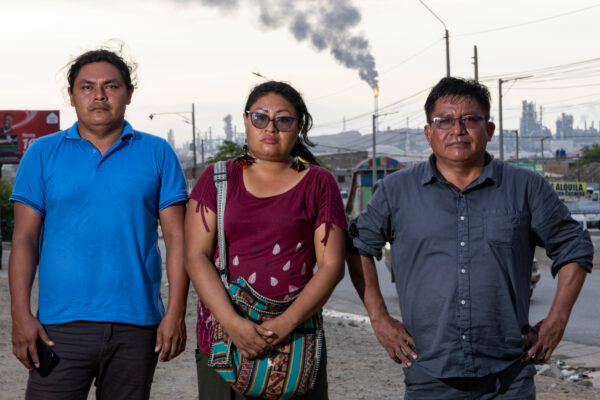 Three river basins in the northern Peruvian Amazon – the Pastaza, the Corrientes, and now the Tigre – have been declared in “environmental states of emergency” as a result of decades of oil-related pollution in Block 1AB. First Occidental Petroleum (Oxy) left a “legacy of harm” and now Pluspetrol has overseen multitudinous oil spills since the year 2000. Peruvian activists recently told Amazon Watch that the question now isn’t what areas of this region have been polluted, but instead what areas are actually still clean.
Three river basins in the northern Peruvian Amazon – the Pastaza, the Corrientes, and now the Tigre – have been declared in “environmental states of emergency” as a result of decades of oil-related pollution in Block 1AB. First Occidental Petroleum (Oxy) left a “legacy of harm” and now Pluspetrol has overseen multitudinous oil spills since the year 2000. Peruvian activists recently told Amazon Watch that the question now isn’t what areas of this region have been polluted, but instead what areas are actually still clean.
Our colleagues at the Arkana Alliance have been monitoring the situation closely from their headquarters in Iquitos, Peru. Below is the second in a series of blog posts about an unprecedented $7 million fine that Pluspetrol is currently facing for having ‘disappeared’ a rainforest lake in the territory of Quichua indigenous people. We encourage you to also read the initial blog, found here on the Alianza Arkana website.
We will continue to repost further blogs from the front lines of defending the Amazon as our allies publish them.
Unmasking Pluspetrol’s Attempt to Manipulate Public Opinion
On Monday November 25th, Peru’s Agency for Environmental Evaluation and Control (OEFA), fined the Argentina-based oil company, Pluspetrol, over US $7 million for irreparable environmental damage and “disappearing” Shanshococha Lake in oil block 1AB (to-be renamed 192) in Northern Peru. Pluspetrol was quick to issue an official communiqué.
Pluspetrol’s response is a disingenuous media campaign targeted at manipulating public opinion; or, more simply put, Pluspetrol is lying. Their attempts to intentionally mislead the public have happened so often and are so preposterous; they almost seems unworthy of a response. But rather than ignore this PR lie, let us briefly deconstruct the ways in which Pluspetrol tries to disclaim all responsibility and present themselves as a responsible enterprise.
 First of all, Pluspetrol’s communiqué speaks of a “remediated and restored lake that was handed back to the native communities.” They include a photo as proof that the supposed “disappeared” lake is most certainly not disappeared.
First of all, Pluspetrol’s communiqué speaks of a “remediated and restored lake that was handed back to the native communities.” They include a photo as proof that the supposed “disappeared” lake is most certainly not disappeared.
Shanshococha Lake, as the pictures in this and previous articles show, as well as the evidence OEFA has collected, has been completely obliterated. The so-called “remediation” Pluspetrol conducted consisted of draining the lake and mixing crude oil with surrounding clean soils. Their reasoning was to diminish the concentration of crude oil per cubic meter of soil. Nothing has been done, however, to clean up the contamination; it was simply “diffused”. Photographic evidence, dozens of testimonials from local witnesses, as well as first hand visits by OEFA all testify to this undeniable fact. This forms the backdrop of the fine by OEFA.
But what about the photo circulated by Pluspetrol portraying a “new” lake? After their “remediation”, the lake refilled with water, and Pluspetrol planted grasses along the shore. From the photo, there undoubtedly appears to be a new, clean lake; and as this site is in an extremely remote area, it is difficult to prove otherwise.
However, nothing is fine with Shanshococha. On the contrary; the site remains an ecological disaster. A lake is more than a picture; more than a pool of water. It is an interlinked ecosystem, connecting complex biological and hydro-geological processes to create the life Shanshococha previously harbored and the ecosystem services it historically provided for the local Quechua population. This is why OEFA, in a second communication, underlined the importance of conducting a hydro-geologic study in order to properly address the situation and possibly restore some of the lost ecosystem services.
The “new” lake that Pluspetrol claims to have remediated is nothing more than a hole filled with water, and not even clean water at that, on still contaminated soil. Delia Morales, an OEFA functionary pointed out to Peruvian TV channel “Canal 35” that the current water volume is only 4% of the volume Shanshococha Lake used to hold. She went on to say that “the lake has not regained the functionality it used to have, providing water for human consumption, habitat for fish, or the possibility for local communities to fish…we’ll never be able to get this lake back the way it was”.
 But one doesn’t need to be a natural scientist to realize that the new lake is a farce, an excuse, a cover-up attempt, a PR stunt. The water is greenish. The earth around it is barren and hard baked. There is little biological life to be seen, but, as indigenous leader David Chino Dahua points out, the people keep consuming the little wildlife that is returning, and as such the contamination ends up in the local population through the food chain. Most shockingly, however, a thin hydrocarbon-film on the water surface indicates the continuous presence of contaminants. In some cases, crude oil can still be observed leaking through to the surface. The pictures in this article, taken in early November 2013, as well as the pictures in OEFA’s second communication released a few days ago, clearly convey this.
But one doesn’t need to be a natural scientist to realize that the new lake is a farce, an excuse, a cover-up attempt, a PR stunt. The water is greenish. The earth around it is barren and hard baked. There is little biological life to be seen, but, as indigenous leader David Chino Dahua points out, the people keep consuming the little wildlife that is returning, and as such the contamination ends up in the local population through the food chain. Most shockingly, however, a thin hydrocarbon-film on the water surface indicates the continuous presence of contaminants. In some cases, crude oil can still be observed leaking through to the surface. The pictures in this article, taken in early November 2013, as well as the pictures in OEFA’s second communication released a few days ago, clearly convey this.
Precisely to avoid such disturbing outcomes, Peruvian law outlines that the State and its relevant experts are required to approve all planned remediation interventions – called environmental management instrument – before they are carried out. Pluspetrol has blatantly defied the state’s authority and implemented this unqualified remediation without informing, nor asking the approval and supervision of responsible state authority. This is the second pillar of the heavy fine attributed to the oil company.
Pluspetrol communicates that they did so due to a “strong demand by the local community of Andoas, and that the intervention had been monitored by the local population”. In this case, this claim is entirely irrelevant. As stated above, Peruvian law clearly delineates that the State must approve and supervise any such intervention. Even if, as Pluspetrol claims, there existed a signed agreement with the community, such an agreement cannot and does not overrule Peruvian law. Neither the community nor Pluspetrol can be the authority to implement such an intervention.
On a side note, it is worth mentioning that in Lote 1AB Pluspetrol has a habit of “arranging” things directly with communities. These “arrangements” are highly unbalanced negotiations, favoring Pluspetrol’s professional lawyers over rural villagers lacking any formal expertise in occidental law. Additionally, it is illegal to make someone renounce and hand over their basic human rights, such as the right to life, a healthy environment and sound living conditions, among others.
Furthermore, in contrast to Pluspetrol’s claim, the Federation of Quechua Indigenous People from the Pastaza (FEDIQUEP) communicated via their umbrella platform PUINAMUDT that they have never asked Pluspetrol to mix crude oil with clean surrounding soils, nor to “disappear” their lake. Rather, in October 2012, FEDIQUEP officially denounced the bad practices of Pluspetrol at Shanshococha to relevant state authorities, asking authorities to halt Pluspetrol’s intervention and start an administrative process to sanction the oil company.
Finally, Pluspetrol claims that the contamination at Shanshococha is the fault of Occidental Petroleum, the oil company that operated in Lot 1AB until the year 2000 when Pluspetrol took over. This is one of Pluspetrol’s favorite arguments, but omits an important reality. According to law, by taking over the concession in 2000, Pluspetrol also assumed the responsibility to remediate impacted areas. Therefore, at best, they haven’t complied with that. However, Shanshococha was not registered as an impacted site in 2000 upon Pluspetrol’s takeover of the oil lot. For such a large site, located so close to a pumping well, it is difficult to believe it could not have been detected. Local communities also tell a different story. Satellite pictures may be able to fill in some of these gaps, and OEFA has access to such detailed data.
Alianza Arkana will shortly release a more detailed article on Pluspetrol’s practices in Northern Peru.














